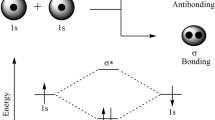Conclusion
This paper has been a preliminary discussion of model confusion about acids and bases, presenting evidence (some of it to be elaborated) that the Arrhenius and the Lowry-Bronsted models are confused in some textbooks, and in many students' minds.
A similar analysis of other concepts in chemistry (are some problems about ions a results of carrying Daltonian and Newtonian models of atoma beyond their utility—since in those models atoms are unbreakable; are covalent bonding ideas served at all well by the Bohr model of the atom?) may be a valuable area for research.
Similar content being viewed by others
References Notes
Note 1. RUSSELL, S. Private communication, 1983.
References
BRADY, J.E., & HUMISTON, G.E.General Chemistry, Principles and Structure (3rd Edition), John Wiley & Sons, New York, 1982.
BURNS, J.R. An Evaluation of 6th and 7th Form Chemistry in Terms of the Needs of the Students and the Community. Report to the Department of Education, Wellington, New Zealand, 1982, pp.96–100.
CHAMPAGNE, A., KLOPFER, E.L., & GUNSTONE, R.F. Cognitive research and the design of science instruction. Paper presented at the International Workshop on problems concerning students' representation of physics and chemistry knowledge, Padagogische Hochschule Ludwigsburg, September 1981.
CHANG, R.Chemistry (2nd Edition) Random House, New York, 1984.
DRIVER, R. & EASLEY, J. Publis and paradigms: A review of literature related to concept development in adolescent science students.Studies in Science Education, 1978,5, 61–84.
DRIVER, R. & ERICKSON G. Theories-in-Action: Some theoretical and empirical issues in the study of students' conceptual frameworks in science.Sturies in Science Education, 1983,10, 37–60.
GILBERT, J.K., OSBORNE, R.J., & FENSHAM, P.J. Children's Science and its consequences for teaching.Science Education, 1982,66(4) 623–33.
GILBERT, J.K. & WATTS, D.M. Concepts, misconceptions and alternative conceptions: Changing perspectives in science education.Studies in Science Education, 1983,10, 61–98.
HELM,, H. Misconceptions in physics amongst South African students.Physics Education, 1980,74, 92–105.
KUHN, T.The Structure of Scientific Revolution. University of Chicago Press, Chicago, 1970.
NOVAK, J.A Theory of Education. Cornell University Press, Ithaca, 1977.
PHILBRICK, E.A., HOLMYARD, E.J., & PALMER, W.G.A Textbook of Theoretical and Inorganic Chemistry. Dent & Sons, London, 1949, p. 193.
STRANKS, D.R., HEFFERNAN, M.L., LEE DOW, K.C., McTIGUE, P.T., & WITHERS, G.R.A.Chemistry. A structural view (2nd Edn) Melbourne University Press, Melbourne 1970.
Rights and permissions
About this article
Cite this article
Carr, M. Model confusion in chemistry. Research in Science Education 14, 97–103 (1984). https://doi.org/10.1007/BF02356795
Issue Date:
DOI: https://doi.org/10.1007/BF02356795



